What We’re Reading: May 11th
Photosynthesis Special Issue
This week’s ‘What We’re Reading’ summarizes the latest papers from the field of photosynthesis research. This includes three reviews: the first focuses on the effect of elevated CO2 on secondary metabolism, the second looks at ways to improve carbon fixation, and the third examines the role of C3 bundle sheath cells in photosynthesis-associated processes. These are followed by seven research papers, covering the role of nitrogen limitation in influencing molecular evolution, two papers on modulating mesophyll conductance, a new insight into the mechanisms of NPQ, how C4 plants outperform C3 species over long-term elevated CO2, natural variation of C4 traits within a species, and a paper aiming to unravel independent O2 fluxes.
Guest Editor: Dr Mike Page
 Mike is a Senior Research Associate (postdoc) at Lancaster University in the UK, and has been a Plantae Fellow since September 2017. He is a molecular biologist with a background in plant abiotic stress responses, including retrograde signaling pathways in which plastids manipulate nuclear gene expression, and the regulation of antioxidant status by light intensity. He is currently using synthetic biology to build the cyanobacterial carbon dioxide concentrating mechanism in rice plastids, with the ultimate aim of boosting photosynthesis and rice yields.
Mike is a Senior Research Associate (postdoc) at Lancaster University in the UK, and has been a Plantae Fellow since September 2017. He is a molecular biologist with a background in plant abiotic stress responses, including retrograde signaling pathways in which plastids manipulate nuclear gene expression, and the regulation of antioxidant status by light intensity. He is currently using synthetic biology to build the cyanobacterial carbon dioxide concentrating mechanism in rice plastids, with the ultimate aim of boosting photosynthesis and rice yields.
Review: New insights into the cellular mechanisms of plant growth at elevated atmospheric carbon dioxide (Plant Cell Environ) $
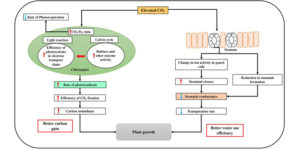 Elevated CO2 (eCO2) encourages plant growth through increased photosynthetic rates and lower stomatal conductance. However, eCO2 also has knock-on effects on plant secondary metabolism, which can also affect plant growth. In this review, Gamage et al explore these ‘post-photosynthetic’ effects in detail. Through analysis of the literature, the authors show that eCO2 modulates carbon metabolism, for example by increasing the levels of sucrose biosynthetic enzymes. They also highlight the importance of the foliar starch:sucrose ratio in determining levels of feedback inhibition on photosynthesis. The authors then introduce the observation that plants grown in eCO2 have a lower leaf nitrogen content. The possible causes of this phenomenon are outlined, since a simple dilution effect caused by increased carbohydrates appears not to be responsible. The authors further describe how growth at eCO2 has been shown to lead to an accelerated cell cycle, as-well-as increased cell wall loosening. The effect of eCO2 on the levels of phytohormones and the activity of their signalling pathways is also discussed. The authors conclude this review by stating the challenges to crop researchers and breeders in developing successful crops for a CO2 enriched atmosphere. (Summary by Mike Page) Plant Cell Environ 10.1111/pce.13206
Elevated CO2 (eCO2) encourages plant growth through increased photosynthetic rates and lower stomatal conductance. However, eCO2 also has knock-on effects on plant secondary metabolism, which can also affect plant growth. In this review, Gamage et al explore these ‘post-photosynthetic’ effects in detail. Through analysis of the literature, the authors show that eCO2 modulates carbon metabolism, for example by increasing the levels of sucrose biosynthetic enzymes. They also highlight the importance of the foliar starch:sucrose ratio in determining levels of feedback inhibition on photosynthesis. The authors then introduce the observation that plants grown in eCO2 have a lower leaf nitrogen content. The possible causes of this phenomenon are outlined, since a simple dilution effect caused by increased carbohydrates appears not to be responsible. The authors further describe how growth at eCO2 has been shown to lead to an accelerated cell cycle, as-well-as increased cell wall loosening. The effect of eCO2 on the levels of phytohormones and the activity of their signalling pathways is also discussed. The authors conclude this review by stating the challenges to crop researchers and breeders in developing successful crops for a CO2 enriched atmosphere. (Summary by Mike Page) Plant Cell Environ 10.1111/pce.13206
Review: Increasing metabolic potential: C-fixation (Essays Biochem) $
 Increasing carbon fixation through the Calvin-Benson-Bassham (CBB) cycle is a viable strategy to boost crop yields, as has been demonstrated through both experimental and modelling approaches. In this review, Andralojc et al outline the most recent advancements in this research field. The authors firstly describe the reaction mechanism of the carbon-fixing enzyme Rubisco, and introduce the various drawbacks of this protein including its liability to misfire or be inhibited, its slow speed compared to other CBB cycle enzymes, and its oxygenase activity. Specificity of Rubisco for CO2 over O2 has long been thought to be part of a trade-off with the catalytic rate of the enzyme. Recently however, extensive biochemical characterisation of Rubisco from a large number of species and lineages has revealed that this trade-off does not always hold, indicating it should be possible to engineer a fast Rubisco with high specificity for CO2. The authors conclude this section by describing how existing computer models of photosynthesis have corroborated that an engineered Rubisco holoenzyme could boost crop yields, as-well-as the prospects of introducing such a protein into crops. This review then discusses the role of Rubisco activase (Rca) in modulating carbon fixation. Rca removes inhibitors from Rubisco in an ATP-dependent manner, a process important for the induction of photosynthesis during low-to-high light transitions (akin to the fluctuating light conditions in the field). The latest research efforts to speed up this induction are described, as are attempts to speed up the regeneration of Rubisco’s substrate (RuBP) through the CBB cycle. Finally, the authors outline potential ways of increasing CO2 in the vicinity of Rubisco, including modulating mesophyll CO2 conductance and the installation of CO2 concentrating mechanisms (CCMs). (Summary by Mike Page) Essays Biochem 10.1042/EBC20170014
Increasing carbon fixation through the Calvin-Benson-Bassham (CBB) cycle is a viable strategy to boost crop yields, as has been demonstrated through both experimental and modelling approaches. In this review, Andralojc et al outline the most recent advancements in this research field. The authors firstly describe the reaction mechanism of the carbon-fixing enzyme Rubisco, and introduce the various drawbacks of this protein including its liability to misfire or be inhibited, its slow speed compared to other CBB cycle enzymes, and its oxygenase activity. Specificity of Rubisco for CO2 over O2 has long been thought to be part of a trade-off with the catalytic rate of the enzyme. Recently however, extensive biochemical characterisation of Rubisco from a large number of species and lineages has revealed that this trade-off does not always hold, indicating it should be possible to engineer a fast Rubisco with high specificity for CO2. The authors conclude this section by describing how existing computer models of photosynthesis have corroborated that an engineered Rubisco holoenzyme could boost crop yields, as-well-as the prospects of introducing such a protein into crops. This review then discusses the role of Rubisco activase (Rca) in modulating carbon fixation. Rca removes inhibitors from Rubisco in an ATP-dependent manner, a process important for the induction of photosynthesis during low-to-high light transitions (akin to the fluctuating light conditions in the field). The latest research efforts to speed up this induction are described, as are attempts to speed up the regeneration of Rubisco’s substrate (RuBP) through the CBB cycle. Finally, the authors outline potential ways of increasing CO2 in the vicinity of Rubisco, including modulating mesophyll CO2 conductance and the installation of CO2 concentrating mechanisms (CCMs). (Summary by Mike Page) Essays Biochem 10.1042/EBC20170014
Review: C4-like photosynthesis has important functions in C3 plant vasculature (JXB)
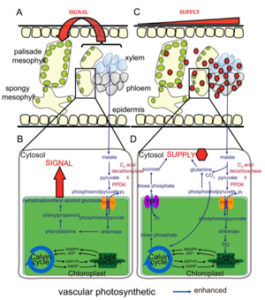 In contrast to the much-studied photosynthetic processes in C4 plant vasculature, the processes in the cells surrounding C3 veins remain much less understood. Here, there appears to be a partial and more spatially-separated C4 pathway, which has been observed in several species including rice, Arabidopsis, Scots pine and celery. In this review, Gao et al examine the evidence for this C4-like pathway, before discussing other metabolic processes that may occur in these specialised bundle sheath cells (BSCs). They outline the evidence that C3 BSCs are involved in recapturing carbon lost during respiration, and assess the literature that supports a role for BSCs in transporting nitrogen. A role for these cells in the sensing and signalling of reactive oxygen species is examined, before the authors conclude with assessing the influence of C3 BSCs on the development of mesophyll cells. (Summary by Mike Page) JXB 10.1093/jxb/ery155
In contrast to the much-studied photosynthetic processes in C4 plant vasculature, the processes in the cells surrounding C3 veins remain much less understood. Here, there appears to be a partial and more spatially-separated C4 pathway, which has been observed in several species including rice, Arabidopsis, Scots pine and celery. In this review, Gao et al examine the evidence for this C4-like pathway, before discussing other metabolic processes that may occur in these specialised bundle sheath cells (BSCs). They outline the evidence that C3 BSCs are involved in recapturing carbon lost during respiration, and assess the literature that supports a role for BSCs in transporting nitrogen. A role for these cells in the sensing and signalling of reactive oxygen species is examined, before the authors conclude with assessing the influence of C3 BSCs on the development of mesophyll cells. (Summary by Mike Page) JXB 10.1093/jxb/ery155
The amount of nitrogen used for photosynthesis modulates molecular evolution in plants (Mol Biol Evol)
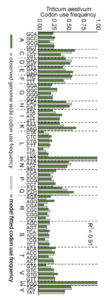 Plant growth is often limited by the availability of nitrogen (N), which is required to synthesise monomers and macromolecules, and is especially important in the synthesis of the carbon assimilating enzymes of the Calvin-Benson-Bassham (CBB) cycle. In this article, Kelly has demonstrated that photosynthetic efficiency is reflected in both genome and transcript nucleotide composition, due to the varying requirement for N in order to synthesise the four nucleotide monomers. For example, species that are less photosynthetically efficient require vast amounts of N-rich Rubisco, and hence they favour the use of synonymous codons that require less N. This strong selection pressure to use less N in transcripts confers a slow rate of evolution on such transcripts, and is especially true for highly abundant transcripts. Up to 10% of the variation in evolutionary rate at synonymous sites could be explained by this phenomenon. Furthermore, when examining basic amino acid residues, the author demonstrated that such species also conserve N by using amino acids with less N in their side chains to synthesise proteins. This study raises the intriguing prospect of increased plant diversification in a future high-CO2 environment: elevated CO2 would lead to enhanced nitrogen use efficiency, which would reduce the selection pressure to minimise the N content of transcripts. (Summary by Mike Page) Mol Biol Evol 10.1093/molbev/msy043
Plant growth is often limited by the availability of nitrogen (N), which is required to synthesise monomers and macromolecules, and is especially important in the synthesis of the carbon assimilating enzymes of the Calvin-Benson-Bassham (CBB) cycle. In this article, Kelly has demonstrated that photosynthetic efficiency is reflected in both genome and transcript nucleotide composition, due to the varying requirement for N in order to synthesise the four nucleotide monomers. For example, species that are less photosynthetically efficient require vast amounts of N-rich Rubisco, and hence they favour the use of synonymous codons that require less N. This strong selection pressure to use less N in transcripts confers a slow rate of evolution on such transcripts, and is especially true for highly abundant transcripts. Up to 10% of the variation in evolutionary rate at synonymous sites could be explained by this phenomenon. Furthermore, when examining basic amino acid residues, the author demonstrated that such species also conserve N by using amino acids with less N in their side chains to synthesise proteins. This study raises the intriguing prospect of increased plant diversification in a future high-CO2 environment: elevated CO2 would lead to enhanced nitrogen use efficiency, which would reduce the selection pressure to minimise the N content of transcripts. (Summary by Mike Page) Mol Biol Evol 10.1093/molbev/msy043
Physiological performance of transplastomic tobacco plants overexpressing aquaporin AQP1 in chloroplast membranes (JXB)
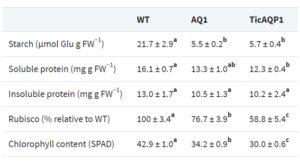 A major factor in determining photosynthetic rate is the availability of CO2 at the site of fixation in the chloroplast stroma. Classically, this has been thought to be mainly limited by stomatal conductance (diffusion from the air, through stomata, to sub-stomatal cavities). However, more recently it has been demonstrated that mesophyll conductance (gm, diffusion from sub-stomatal cavities to the stroma) also influences stromal CO2 concentrations. A major site of resistance to leaf CO2 diffusion is at the protein-rich chloroplast envelope. As such, efforts have been made to make the chloroplast envelope more permeable to CO2, through the nuclear expression of aquaporins targeted to this double membrane. Aquaporins are pore-forming proteins that enhance membrane permeability of membranes to small neutral molecules, and these studies have already shown that photosynthetic performance can be boosted using this approach. In the current study, Fernández-San Millán et al transformed the chloroplast genome of tobacco to achieve high levels of aquaporin protein accumulation in the chloroplast envelope. Surprisingly, photosynthetic performance of the transgenic lines was compromised and growth retarded, potentially due to a reduction in gm. In addition, some aquaporin protein localised to thylakoid membranes, and the authors provide evidence that thylakoid membrane integrity was diminished. This study highlights the challenges involved in engineering improvements in gm. (Summary by Mike Page) JXB 10.1093/jxb/ery148
A major factor in determining photosynthetic rate is the availability of CO2 at the site of fixation in the chloroplast stroma. Classically, this has been thought to be mainly limited by stomatal conductance (diffusion from the air, through stomata, to sub-stomatal cavities). However, more recently it has been demonstrated that mesophyll conductance (gm, diffusion from sub-stomatal cavities to the stroma) also influences stromal CO2 concentrations. A major site of resistance to leaf CO2 diffusion is at the protein-rich chloroplast envelope. As such, efforts have been made to make the chloroplast envelope more permeable to CO2, through the nuclear expression of aquaporins targeted to this double membrane. Aquaporins are pore-forming proteins that enhance membrane permeability of membranes to small neutral molecules, and these studies have already shown that photosynthetic performance can be boosted using this approach. In the current study, Fernández-San Millán et al transformed the chloroplast genome of tobacco to achieve high levels of aquaporin protein accumulation in the chloroplast envelope. Surprisingly, photosynthetic performance of the transgenic lines was compromised and growth retarded, potentially due to a reduction in gm. In addition, some aquaporin protein localised to thylakoid membranes, and the authors provide evidence that thylakoid membrane integrity was diminished. This study highlights the challenges involved in engineering improvements in gm. (Summary by Mike Page) JXB 10.1093/jxb/ery148
Cell wall properties in Oryza sativa influence mesophyll CO2 conductance (New Phytol) $
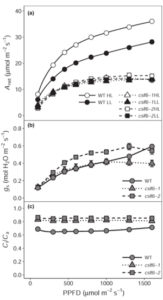 Mesophyll CO2 conductance (gm) is an important factor in determining the concentration of CO2 at the site of fixation in the chloroplast stroma, and as such is crucial for determining photosynthetic capacity. The mesophyll cell wall provides a major site of resistance to CO2 diffusion into the stroma from the intercellular air space. Ellsworth et al investigated the effect of modulating cell wall properties on gm. The authors studied cslf6 mutants of rice, which do not have detectable mixed-linkage glucans (MLGs) in their cell walls. While these mutants had thinner cell walls, their effective porosity was reduced, leading to a marked reduction in gm. This was likely caused by modification of both porosity and tortuosity of cslf6 cell walls. This study emphasises the important role cell wall composition plays in determining CO2 diffusion and, consequently, photosynthetic capacity. (Summary by Mike Page) New Phytol 10.1111/nph.15173
Mesophyll CO2 conductance (gm) is an important factor in determining the concentration of CO2 at the site of fixation in the chloroplast stroma, and as such is crucial for determining photosynthetic capacity. The mesophyll cell wall provides a major site of resistance to CO2 diffusion into the stroma from the intercellular air space. Ellsworth et al investigated the effect of modulating cell wall properties on gm. The authors studied cslf6 mutants of rice, which do not have detectable mixed-linkage glucans (MLGs) in their cell walls. While these mutants had thinner cell walls, their effective porosity was reduced, leading to a marked reduction in gm. This was likely caused by modification of both porosity and tortuosity of cslf6 cell walls. This study emphasises the important role cell wall composition plays in determining CO2 diffusion and, consequently, photosynthetic capacity. (Summary by Mike Page) New Phytol 10.1111/nph.15173
Dynamic feedback of the photosystem II reaction centre on photoprotection in plants (Nat Plants) $
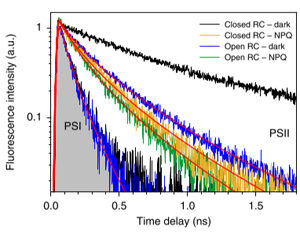 The light reactions of photosynthesis are under constant regulation in order to continue operating efficiently and avoid photodamage in a fluctuating light environment. One mechanism to avoid photodamage is the dissipation of excess excitation energy as heat, which can be determined by measuring non-photochemical quenching (NPQ) of chlorophyll fluorescence. The various mechanisms responsible for NPQ are poorly understood, including the number of NPQ processes that operate in photosystem II (PSII), and differences in NPQ mechanisms for open or closed PSII reaction centres. Here, Farooq et al used picosecond fluorescence analysis on spinach leaves to investigate NPQ processes for open and closed reaction centres. They provide evidence for at least two quenching mechanisms, and show that one of these is only active when PSII reaction centres are closed, with subsequent rapid inactivation upon opening of reaction centres. In addition, opening reaction centres provides an instant feedback to the antenna to reduce the rate of NPQ, improving photosynthetic efficiency. The authors conclude by discussing the potential mechanisms responsible for these phenomena. (Summary by Mike Page) Nat Plants 10.1038/s41477-018-0127-8
The light reactions of photosynthesis are under constant regulation in order to continue operating efficiently and avoid photodamage in a fluctuating light environment. One mechanism to avoid photodamage is the dissipation of excess excitation energy as heat, which can be determined by measuring non-photochemical quenching (NPQ) of chlorophyll fluorescence. The various mechanisms responsible for NPQ are poorly understood, including the number of NPQ processes that operate in photosystem II (PSII), and differences in NPQ mechanisms for open or closed PSII reaction centres. Here, Farooq et al used picosecond fluorescence analysis on spinach leaves to investigate NPQ processes for open and closed reaction centres. They provide evidence for at least two quenching mechanisms, and show that one of these is only active when PSII reaction centres are closed, with subsequent rapid inactivation upon opening of reaction centres. In addition, opening reaction centres provides an instant feedback to the antenna to reduce the rate of NPQ, improving photosynthetic efficiency. The authors conclude by discussing the potential mechanisms responsible for these phenomena. (Summary by Mike Page) Nat Plants 10.1038/s41477-018-0127-8
Measurement of gross photosynthesis, respiration in the light, and mesophyll conductance using H218O labeling (Plant Physiol)
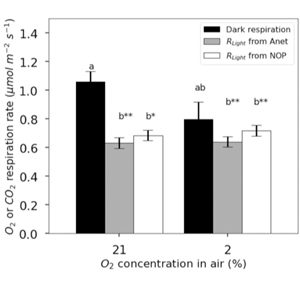 It is relatively simple to determine net O2 flux in leaves. However, this data provides no information on the underlying processes responsible for this flux, namely gross oxygen production (GOP, water splitting), mitochondrial respiration in light, Rubisco oxygenation, and photorespiration. In this ‘Breakthrough Technologies’ paper, Gauthier et al outline a method that utilises H218O labelling to precisely measure both net oxygen production (NOP) and GOP for detached leaves. This was performed in a chamber with regulated temperature and humidity, and conventional CO2 and light response curves were performed simultaneously. As a proof of concept, the authors used this technique to determine O2 metabolism in leaves of Phaseolus vulgaris, and examined both the light response of mesophyll CO2 conductance and the Kok effect. (Summary by Mike Page) Plant Physiol 10.1104/pp.16.00741
It is relatively simple to determine net O2 flux in leaves. However, this data provides no information on the underlying processes responsible for this flux, namely gross oxygen production (GOP, water splitting), mitochondrial respiration in light, Rubisco oxygenation, and photorespiration. In this ‘Breakthrough Technologies’ paper, Gauthier et al outline a method that utilises H218O labelling to precisely measure both net oxygen production (NOP) and GOP for detached leaves. This was performed in a chamber with regulated temperature and humidity, and conventional CO2 and light response curves were performed simultaneously. As a proof of concept, the authors used this technique to determine O2 metabolism in leaves of Phaseolus vulgaris, and examined both the light response of mesophyll CO2 conductance and the Kok effect. (Summary by Mike Page) Plant Physiol 10.1104/pp.16.00741
Unexpected reversal of C3 versus C4 grass response to elevated CO2 during a 20-year field experiment (Science) $
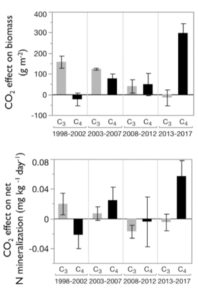 It is widely accepted that the growth of C3 plants responds more to elevated CO2 (eCO2) than that of C4 plants, since photosynthesis in C3 plants is more limited by the current atmospheric CO2:O2 ratio due to the oxygenase activity of Rubisco. This has been established empirically in short-term eCO2 experiments. In this study, Reich et al presented a 20 year field eCO2 experiment consisting of four C3 grass species and four C4 grasses. While C3 biomass responded better to eCO2 earlier in the trial, the C4 biomass response gradually overtook the C3 response towards the end of the trial. The authors present data to suggest that this reversal was not due to changes in leaf level photosynthesis over time, while any associations between eCO2 responsiveness and temperature or rainfall were inconsistent and weak over the trial period. Instead, there was an association between soil net nitrogen mineralisation and biomass for both C3 and C4 species, and this trait differed over time in the C3 and C4 plots. The reason for these differences in soil nitrogen availability remains unexplained, but this study reinforces a need to take a long-term approach to evaluating the effect of eCO2 on crop productivity. (Summary by Mike Page) Science 10.1126/science.aas9313
It is widely accepted that the growth of C3 plants responds more to elevated CO2 (eCO2) than that of C4 plants, since photosynthesis in C3 plants is more limited by the current atmospheric CO2:O2 ratio due to the oxygenase activity of Rubisco. This has been established empirically in short-term eCO2 experiments. In this study, Reich et al presented a 20 year field eCO2 experiment consisting of four C3 grass species and four C4 grasses. While C3 biomass responded better to eCO2 earlier in the trial, the C4 biomass response gradually overtook the C3 response towards the end of the trial. The authors present data to suggest that this reversal was not due to changes in leaf level photosynthesis over time, while any associations between eCO2 responsiveness and temperature or rainfall were inconsistent and weak over the trial period. Instead, there was an association between soil net nitrogen mineralisation and biomass for both C3 and C4 species, and this trait differed over time in the C3 and C4 plots. The reason for these differences in soil nitrogen availability remains unexplained, but this study reinforces a need to take a long-term approach to evaluating the effect of eCO2 on crop productivity. (Summary by Mike Page) Science 10.1126/science.aas9313
Natural variation within a species for traits underpinning C4 photosynthesis (Plant Physiol)
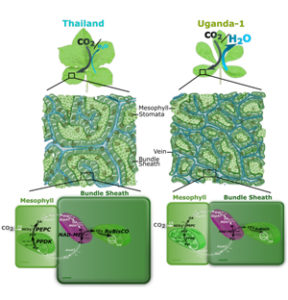 While C4 photosynthesis is relatively well understood, the research community is still some distance from converting a C3 crop to one that performs C4 photosynthesis. There are many reasons for this, including the complex requirement to reconstitute Kranz leaf anatomy in a C3 species, and the elusive search for regulators of C4 gene expression. The classical approach for identifying such regulators would be through quantitative trait loci (QTL) mapping or a genome wide association study (GWAS). However, these methods rely on the presence of natural variation of a phenotype within a species, something as yet undiscovered for C4 photosynthesis. In this manuscript, Reeves et al demonstrated that accessions of Gynandropsis gynandra collected from Asia and Africa possessed significant variation in both physiological and anatomical C4 traits, providing the variation necessary to perform QTL mapping or GWAS. In addition, these accessions could be hybridised and produced fertile offspring. This important discovery provides the opportunity to identify the components regulating C4 photosynthesis through classical genetics. (Summary by Mike Page) Plant Physiol 10.1104/pp.18.00168
While C4 photosynthesis is relatively well understood, the research community is still some distance from converting a C3 crop to one that performs C4 photosynthesis. There are many reasons for this, including the complex requirement to reconstitute Kranz leaf anatomy in a C3 species, and the elusive search for regulators of C4 gene expression. The classical approach for identifying such regulators would be through quantitative trait loci (QTL) mapping or a genome wide association study (GWAS). However, these methods rely on the presence of natural variation of a phenotype within a species, something as yet undiscovered for C4 photosynthesis. In this manuscript, Reeves et al demonstrated that accessions of Gynandropsis gynandra collected from Asia and Africa possessed significant variation in both physiological and anatomical C4 traits, providing the variation necessary to perform QTL mapping or GWAS. In addition, these accessions could be hybridised and produced fertile offspring. This important discovery provides the opportunity to identify the components regulating C4 photosynthesis through classical genetics. (Summary by Mike Page) Plant Physiol 10.1104/pp.18.00168



